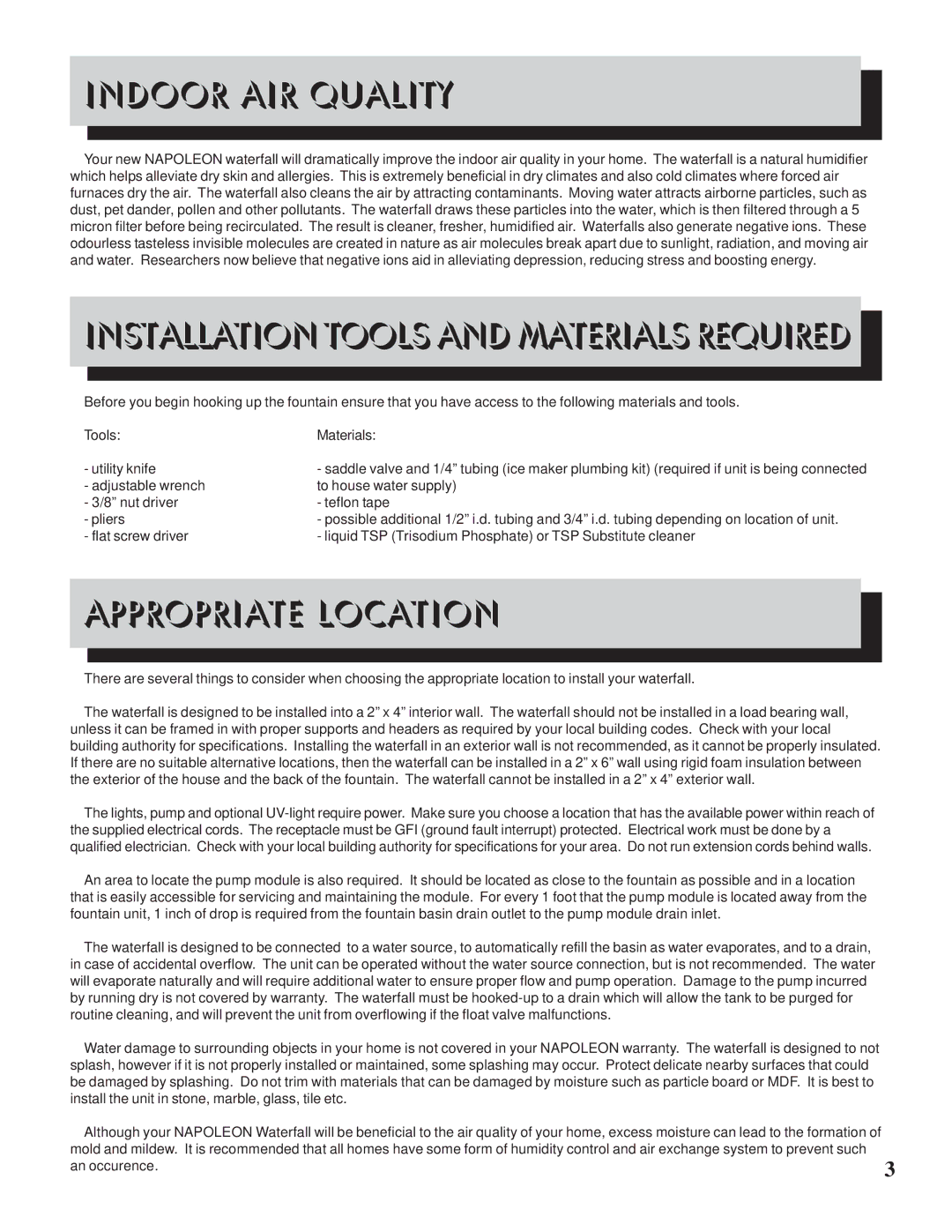
indoor air quality
Your new NAPOLEON waterfall will dramatically improve the indoor air quality in your home. The waterfall is a natural humidifier which helps alleviate dry skin and allergies. This is extremely beneficial in dry climates and also cold climates where forced air furnaces dry the air. The waterfall also cleans the air by attracting contaminants. Moving water attracts airborne particles, such as dust, pet dander, pollen and other pollutants. The waterfall draws these particles into the water, which is then filtered through a 5 micron filter before being recirculated. The result is cleaner, fresher, humidified air. Waterfalls also generate negative ions. These odourless tasteless invisible molecules are created in nature as air molecules break apart due to sunlight, radiation, and moving air and water. Researchers now believe that negative ions aid in alleviating depression, reducing stress and boosting energy.
installation Tools and materials required
Before you begin hooking up the fountain ensure that you have access to the following materials and tools.
Tools: | Materials: |
- utility knife | - saddle valve and 1/4” tubing (ice maker plumbing kit) (required if unit is being connected |
- adjustable wrench | to house water supply) |
- 3/8” nut driver | - teflon tape |
- pliers | - possible additional 1/2” i.d. tubing and 3/4” i.d. tubing depending on location of unit. |
- flat screw driver | - liquid TSP (Trisodium Phosphate) or TSP Substitute cleaner |
appropriate location
There are several things to consider when choosing the appropriate location to install your waterfall. |
|
The waterfall is designed to be installed into a 2” x 4” interior wall. The waterfall should not be installed in a load bearing wall, |
|
unless it can be framed in with proper supports and headers as required by your local building codes. Check with your local |
|
building authority for specifications. Installing the waterfall in an exterior wall is not recommended, as it cannot be properly insulated. |
|
If there are no suitable alternative locations, then the waterfall can be installed in a 2” x 6” wall using rigid foam insulation between |
|
the exterior of the house and the back of the fountain. The waterfall cannot be installed in a 2” x 4” exterior wall. |
|
The lights, pump and optional |
|
the supplied electrical cords. The receptacle must be GFI (ground fault interrupt) protected. Electrical work must be done by a |
|
qualified electrician. Check with your local building authority for specifications for your area. Do not run extension cords behind walls. |
|
An area to locate the pump module is also required. It should be located as close to the fountain as possible and in a location |
|
that is easily accessible for servicing and maintaining the module. For every 1 foot that the pump module is located away from the |
|
fountain unit, 1 inch of drop is required from the fountain basin drain outlet to the pump module drain inlet. |
|
The waterfall is designed to be connected to a water source, to automatically refill the basin as water evaporates, and to a drain, |
|
in case of accidental overflow. The unit can be operated without the water source connection, but is not recommended. The water |
|
will evaporate naturally and will require additional water to ensure proper flow and pump operation. Damage to the pump incurred |
|
by running dry is not covered by warranty. The waterfall must be |
|
routine cleaning, and will prevent the unit from overflowing if the float valve malfunctions. |
|
Water damage to surrounding objects in your home is not covered in your NAPOLEON warranty. The waterfall is designed to not |
|
splash, however if it is not properly installed or maintained, some splashing may occur. Protect delicate nearby surfaces that could |
|
be damaged by splashing. Do not trim with materials that can be damaged by moisture such as particle board or MDF. It is best to |
|
install the unit in stone, marble, glass, tile etc. |
|
Although your NAPOLEON Waterfall will be beneficial to the air quality of your home, excess moisture can lead to the formation of |
|
mold and mildew. It is recommended that all homes have some form of humidity control and air exchange system to prevent such | 3 |
an occurence. |
